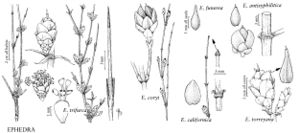Ephedra trifurca
Botany (Fortieth Parallel): 329. 1871.
Shrubs erect, 0.5–5 m. Bark gray, cracked and irregularly fissured. Branches alternate or whorled, rigid, angle of divergence about 30°. Twigs pale green, becoming yellow, then gray with age, glaucous, with numerous very fine longitudinal grooves; internodes 3–10 cm. Terminal buds spinelike, to 10 mm. Leaves in whorls of 3, 5–15 mm, connate to 1/2–3/4 their length; bases becoming gray and shredded with age; apex spinose. Pollen cones 1–several at node, obovoid, 6–10 mm, on short, scaly peduncles; bracts in 8–12 whorls of 3, reddish-brown, obovate, slightly clawed, 3–4 × 2–3 mm, membranous; bracteoles nearly equaling bracts; sporangiophores 4–5 mm, exserted to 1/4 their length, with 4–5 short-stalked microsporangia. Seed-cones 1–several at node, obovoid, 10–15 mm, on short, scaly peduncles (rarely sessile); bracts in 6–9 whorls of 3, circular, 8–12 × 8–12 mm, papery, translucent with reddish-brown center and base, base clawed, margins entire. Seeds 1 (–3), ellipsoid, 8–15 × 1.5–3 mm, light-brown, smooth.
Phenology: Coning late winter–early spring.
Habitat: Dry rocky slopes to flat sandy areas
Elevation: 500–2000 m
Distribution

Ariz., Calif., N.Mex., Tex., Mexico in Baja California, Chihuahua, Coahuila, Sonora
Discussion
The hybrid Ephedra × intermixta is discussed under E. torreyana.
Selected References
None.
Lower Taxa
"/2-3/4" is not declared as a valid unit of measurement for this property.
